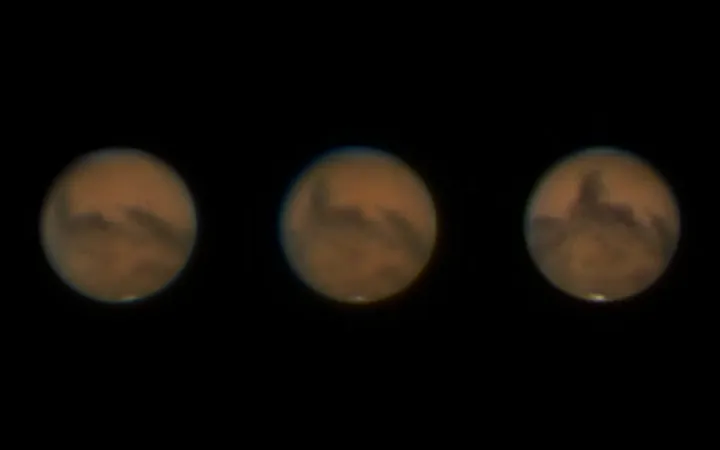
Spectacular Celestial Events Unfold from January 10 to 17: Mars Shines at Opposition!
2025-01-10
Author: Sarah
Get ready, stargazers!
This week promises an extraordinary display of celestial wonders, highlighted by Mars reaching its opposition, making it one of the best times to observe the Red Planet in all its glory. Here’s your guide to the key astronomical events happening in the night sky.
Friday, January 10
As the waxing gibbous Moon rises, it will pass just 5° north of Jupiter at 6 P.M. EST. If you look closely, you can find Jupiter shining brightly at a magnitude of -2.7, following its recent opposition. The Moon will form a triangle with the prominent star Elnath and Jupiter.
Additionally, don’t miss the Pleiades star cluster, located to the Moon's upper right, which was recently occulted by our lunar neighbor. Just three days from now, the Moon will again take center stage as it passes in front of Mars—a must-see event visible throughout much of the U.S.
Saturday, January 11
Mark your calendars! Today is significant for Venus, which reaches its dichotomy, appearing half-illuminated. As it shines at a magnitude of -4.5, Venus will grace the southwestern sky for almost four hours post-sunset. Keep an eye out for Saturn nearby, as it makes a stunning sight alongside Venus.
With a telescope, lovers of astronomy can observe Venus's disk, which measures an impressive 25” across. Don’t forget to document the phase, as the atmospheric conditions can cause variations in its appearance!
Sunday, January 12
Prepare for an exhilarating astronomical event—Mars is at its closest approach to Earth today, at a distance of 59.7 million miles (96.1 million km). In just a day, Mars will be at opposition, but first, get ready for the Moon to occult Mars tomorrow evening, creating an incredible viewing opportunity across North America.
Look south in the early evening to spot Orion and its radiant belt while also seeking out the fascinating variable star, Mira, in the constellation Cetus.
Monday, January 13
Tonight marks the Full Moon, commonly known as the Wolf Moon, which reaches its peak at 5:27 P.M. EST. As the Moon rises in Gemini on this beautiful evening, it will approach Mars, leading to an occultation that should not be missed! Timing varies by location—be sure to tune in as the Moon conceals the Red Planet, offering a display of cosmic phenomena visible from various parts of the world.
Tuesday, January 14
Saturn remains a dazzling sight in the evening sky, positioned just 4° above Venus. Use a telescope to see the spectacular rings of Saturn, and observe its bright moon Titan nearby. Tonight also features an intriguing occultation of Rhea, adding to the variety of sights for eager astronomers.
Wednesday, January 15
The wait is over—Mars opposition occurs at 10 P.M. EST today! The Red Planet will be incandescent, brightening the eastern sky and highlighting its remarkable features. This is the moment to capture details of Mars's surface, including the famed Sinus Meridiani. With optimal viewing conditions, the views will be spectacular!
Thursday, January 16
Tonight, focus on Jupiter as it shines in Taurus, accompanied by its moons. The transit of Io will be visible, providing an additional layer of excitement for watchers. Don’t miss the chance to witness Ganymede and its shadow create a fabulous display as they interact with the gas giant.
Friday, January 17
Attention early risers! This day might be your last opportunity to catch Mercury before it sets into the twilight. With a magnitude of -0.5, it remains a bright point, positioned just 2° above the horizon before sunrise. Once it dips below the horizon, you’ll have to wait until late February to catch another glimpse of this elusive planet.
Conclusion
So, grab your telescopes and prepare for a week full of astronomical events that will light up the night sky! Don’t let these extraordinary opportunities pass you by; mark your calendars and join the cosmic celebration happening above us!
 Brasil (PT)
Brasil (PT)
 Canada (EN)
Canada (EN)
 Chile (ES)
Chile (ES)
 Česko (CS)
Česko (CS)
 대한민국 (KO)
대한민국 (KO)
 España (ES)
España (ES)
 France (FR)
France (FR)
 Hong Kong (EN)
Hong Kong (EN)
 Italia (IT)
Italia (IT)
 日本 (JA)
日本 (JA)
 Magyarország (HU)
Magyarország (HU)
 Norge (NO)
Norge (NO)
 Polska (PL)
Polska (PL)
 Schweiz (DE)
Schweiz (DE)
 Singapore (EN)
Singapore (EN)
 Sverige (SV)
Sverige (SV)
 Suomi (FI)
Suomi (FI)
 Türkiye (TR)
Türkiye (TR)
 الإمارات العربية المتحدة (AR)
الإمارات العربية المتحدة (AR)